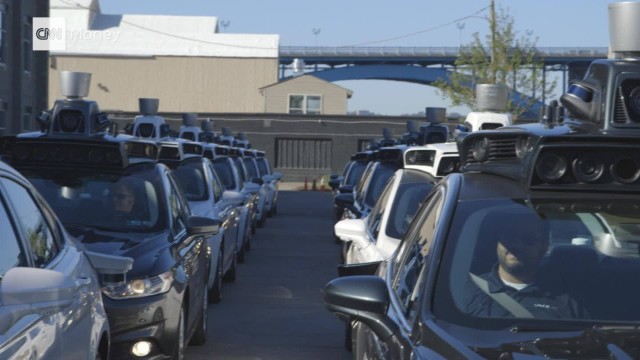About 20 minutes into my ride in a self-driving Uber, I got a nonchalant offer: Did I want to sit behind the wheel?
I’d already seen our Ford Fusion get cut off. And then there was the flatbed that veered into our lane, forcing my cautious test driver to take control and steer us to safety.
We’d navigated around impatient pedestrians, cyclists and unmarked railroad crossings on Pittsburgh’s narrow, well-worn roads. The conditions felt a lot tougher than my first trip in a fully self-driving car, about a year ago at Google’s headquarters.
“Oh sure, I’ll go for it,” I said, feeling a mix of excitement and anxiety. I knew my editor wouldn’t be happy if I said no.
So in a gravel lot a stone’s throw from the Allegheny River, I left the safety of the Fusion’s backseat and climbed behind the wheel.
The two Uber employees I was riding with provided a crash course in how not to, well, crash. If things got hairy, I could hit the brake or a giant red button on the center console to regain control of the Fusion.do you
Starting Wednesday, Uber will be offering Pittsburgh customers the option of riding in about a dozen these cars. Passengers will sit in the back while two Uber employees in the front seats monitor the car’s performance. Uber isn’t saying when it will expand self-driving tests to other cities, or when the cars will operate without test drivers.
If self-driving cars work, the impact on society could be huge. Roads may become safer and transportation could be cheaper and more accessible — but many drivers may lose their jobs.
For this revolution to happen, people will have to be willing to literally go along for the ride. Research has shown that most U.S. residents aren’t ready to trust self-driving cars yet. The Pittsburgh trials are a way for Uber to see how customers react to the cars, and what makes them uncomfortable.
For me, there’s nothing alarming about riding in a self-driving car. But I started worrying once I was behind the wheel.
“Just don’t crash this car,” I thought as I adjusted the mirrors. The Fusion was decked out with a small fortune of computing gear — 20 cameras, seven lasers and 360-degree radar coverage. It has more computing power on board than you’ll find in a typical small business, one Uber engineer told me. Repairs would be especially expensive.
On River Avenue, I hit a chrome button on the center console and the car was suddenly driving itself. We plodded along at 25 mph, vigilantly honoring the speed limit. I held my hands gently on the wheel, and could feel it shifting back and forth ever so slightly to remain in the middle of our lane.
As we approached a red light, the car eased to a stop behind a Kia. So far, so good. The turn signal flicked on, and we soon turned right onto the 31st Street Bridge.
The car corners at a consistent angle, making turns that are slower and wider than the typical driver. At another intersection, a truck blared its horn as we turned, apparently frustrated with the car’s scrupulous style.
The car’s first real test with me at the helm came a few minutes later on Penn Ave. The car put on its right blinker and slowed for a turn. But a cyclist was overtaking us on our right.
I’d driven the old fashioned way, all the way from Washington, D.C., for a moment just like this. Could the car handle a tricky situation?
The cyclist kept pedaling, pulling a half-car length ahead of us at the intersection. The car appeared to have aced the test as we started another methodical, gentle turn. But a chime sounded, indicating that the car wanted me to take over. I guided the car through the rest of the turn. It was more than the car was programmed to handle on its own.
A few blocks later, the car was back in autonomous mode and hugging the right side of the lane, just a couple feet from a row of parked cars. I resisted the urge to jerk the wheel to the left.
We passed the parked cars without incident and came up to a truck parked in the middle of our lane, facing the wrong direction. I tapped the brake, and piloted the car around the truck, following the advice of the safety drivers. They felt the car could handle the challenge, but wanted to err on the safe side with a newbie behind the wheel.
I spent almost an hour in the Ford Fusion, and six minutes behind the wheel. Between the test drivers and myself, we intervened five times. The drivers are taught to be especially cautious and will intervene even if the car doesn’t request it.
If Uber’s cars are ever good enough to drive around Pittsburgh without a test driver behind the wheel, Uber’s business will rapidly transform. Customers could book less expensive rides because there’s no need to pay a human driver. Uber believes self-driving cars will hasten a shift to a world where no one needs to own a car.
Uber is testing in Pittsburgh because it hired a group of robotics experts from nearby Carnegie Mellon University. The city’s nature also provides a range of useful challenges.
Aaron Steinfeld, an associate research professor working on autonomous vehicles at Carnegie Mellon, believes there is no better city to do autonomous vehicle research.
“We have everything going on here,” Steinfeld said. “We have weather, we have hills, we have bridges, we have tunnels, we have all kinds of drivers. We’re in the sweet spot of East Coast and Midwest drivers so you see all sorts of behavior.”
